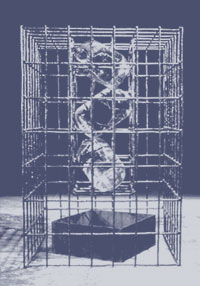
|
ARTIST |
|
SCULPTURE |
|
MORE |
|
GALLERY |
ALUMINUM |
RUBBER |
LIGHT |
CAGES |
BOTTLES |
STONES
|

|
||||||
|
|
|
||||
|
|
|
|
 The Ambiguity of Thomas Skomski’s Works
Yukio Kondo |
When one thinks of a cage in Thomas Skomski’s work as a metaphor for prison, various interpretations are conceivable, without even referring to Michel Foucault. The artist himself does not deny such possibility, and there is a danger that such interpretation gains independence, and consequently, creates another and quite different universe from his works. Skomski, rather, aims at the duality of a cage. He seems to want to turn the viewer’s interest to the fact that two conflicting functions are co-existing: that is, a cage protects us from enemy’s attack, while it also confines the danger inside. In his text for the exhibition of “Sculpture Chicago ’89,” Skomski tells us that such opposing concepts as reality and illusion, love and hate, are able to flip into their opposites in ideas, concepts and feeling. The opposing concepts are dualism, the foundation of Western ideas. In contrast, such skepticism, to consider them only as a norm that man created, and the absolute being does not exist in the dispensation of Natures, and in cases, they are easily reversed, belongs to Eastern ideas. When one thinks about Skomski being strongly interested in Zen, it probably is a natural conclusion. If one point out the characteristic of Skomski’s works in the same context, it is that the spiritual, or non-materialistic being is placed above the material world. We can see in Zen teachings the attitudes of observing such non-material being as spirit or idea, rising above the actual and material world. The physical presence in Skomski’s works is subtle. They are not sanctifies as art and set apart from common objects. Common objects are incorporated into his works, but they are not used as a strong paradox seen in the early ready-made objects. His are only devices. From his work of a few years ago that uses light reflecting through a glass container filled with water, to his later work of a cage, they are only devices to actualize and visualize the matters and relationships that we often overlook in our daily life. Sometimes, what is realized is mysterious or magical, like a work of an alchemist. Here, the texture of materials that construct his works is vanished, and the materials turn out to be no more than the neutral medium. The conceptual artists have specified that the ultimate purpose of artistic expression is a question of what is art. It is needless to say that to achieve this, all factors bearing traces of the personal have been removed, and photographs and words are used as a means of expression. Skomski’s works of ready-made objects and conceptual art enable us to consider him as a rightful successor to the history of European and American contemporary art. However, it is futile to discuss whether his origin is in the West or East. Here, I only would like to confirm that as a neutral medium or a mere device, the existence of Skomski’s work itself is ignored. What happens if the concept of sculpture is brought in here? The emphasis on the texture of material itself, that is, the primitive expression by wooden and stone carving, is the characteristic of the twentieth century sculpture. It was an antithesis of illusion found in the traditional sculpture of the nineteenth century or earlier. It is an illusion to express the softness of drapery and skin in bronze, similar to expressing three-dimensional space in painting. Parallel to painters who had recovered the direct relation with paint itself, sculptors had also changed their attitude toward materials. We can see clearly the shift from the visual to the tactile. Afterward, the importance on material is to be a notable characteristic of contemporary sculpture. It corresponds with such social and cultural consciousness as environmental and ecological matters and is becoming the most acceptable stand by the general public. However, are they losing their original freshness today and reduced to a shell? It seems to me that Skomski is saying such exaggerated fetishism is only a farce in a great social cycle. We can see that as the paradox of tactility he has brought in the visual elements again. Skomski’s works which deal with light are always visual. But the paradox of a paradox is not a return to the original point, that is, a return to traditional sculpture. For Skomski, the light probably is a metaphor of truth. It is omnipresent but as it is, it is overlooked, requiring a device to make one recognize its presence. Skomski’s works, in the sense, are devices. He seems to fling a statement to the world that to free ourselves from petty fetishism, and turn to the metaphysical, is the very essence of art. It no longer matters whether it has derived from Zen or new conceptual art. Peter Spooner points out in his catalogue text for the exhibition, Biokinetic, in which Skomski participated, that contrary to the glorification of machinery in the early twentieth century, there is not much meaning to artists today in using machines in their works: rather, with this method, they try to express very human elements. They, at first glance, seem to be practical, but not so. They warn us about the danger to spirit today and try to see beyond the material excess. What is important in Skomski’s work is not only its expressive content, but for us to be able to find the circumstances we are placed in today when we interpret his works. In that sense, Skomski’s works can be called the ambiguous devices. |